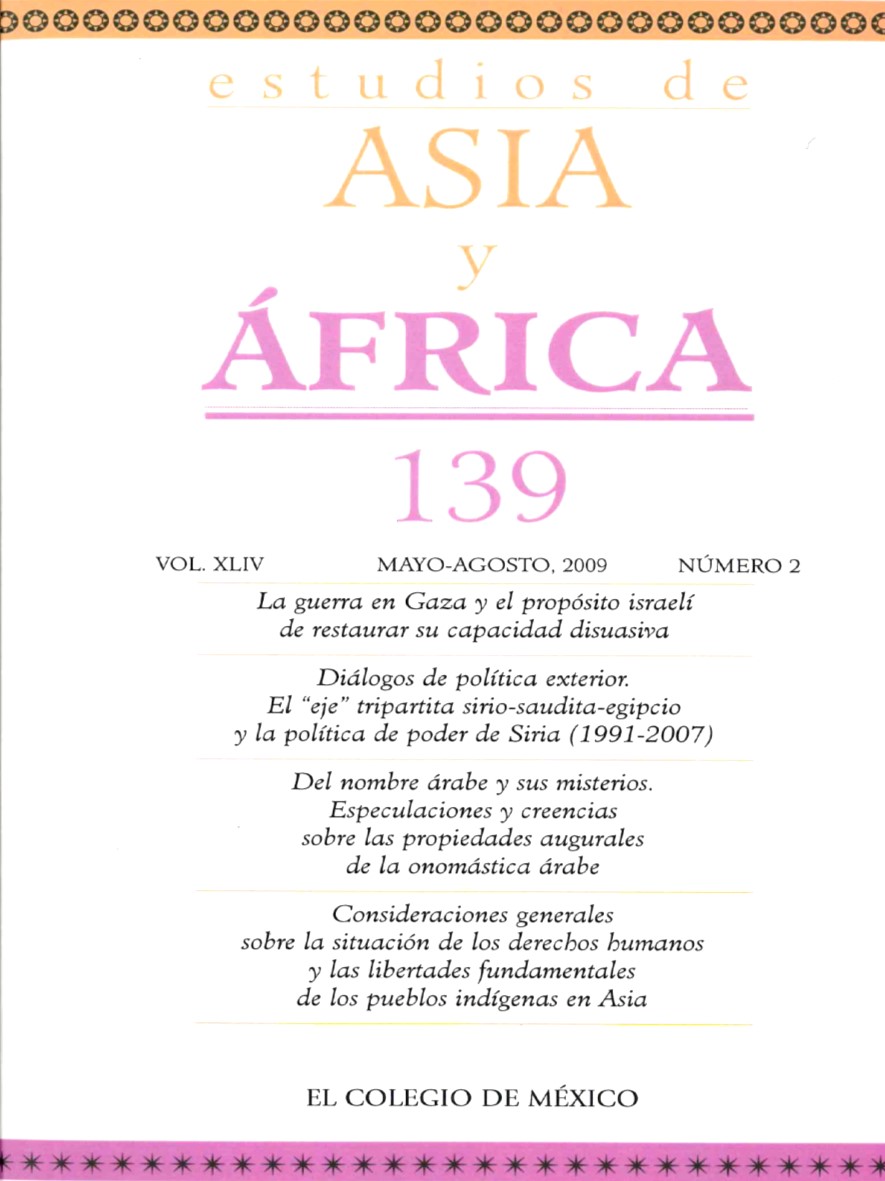Abstract
Traditionally, Arabic culture scholars have discussed the peculiar nature of Arabic onomastics, focusing on the tough and unpleasant qualities of many of the pre-Islamic names, as opposed to the nomina boni augurii stream imposed by Islam and the Prophet Muhammad’s belief in onomatopoeic omens derived from names. It is worth noting the resemblance of this controversy among the Islamists on the pre-Islamic names, in a context of ethnic and cultural Persian-Arabic rivalry traditionally known as šu‘ūbiyya, with the modern attempts to explain the nature of Arabic names in terms of fear of the “evil eye”, antiphrasis and taboos relating to certain animals. This article aims to describe and study different explanations and analyses that the rich and complex system of Arabic onomastics has produced throughout its history.
References
Barbier de Meynard, A.-C., “Surnoms et sobriquets dans la Littérature arabe”, tomado de Journal Asiatique, París, Imprimerie nationale, 1907.
Benkheira M. H., C. Mayeur-Jaouen y J. Sublet, L’Animal en Islam, París, Les Indes Savantes, 2005.
Bernárdez, E., “Sobre la traducción de los kenningar y otros aspectos de la poesía escáldica”, Filología moderna, 68-70, 1981, pp. 223-240.
Caetani, L. y G. Gabrieli, Onomasticon Arabicum, 2 vols., Roma, 1915.
Contenau, G., “De la valeur du nom chez les babyloniens et de ses conséquences”, Revue de l’Histoire des Réligions, 81, París, 1920, pp. 316-332.
Doutté, E., Magie et Religion dans l’Afrique du Nord, Argel, 1909.
Encyclopaedia of Islam, 2ª ed., Leiden, Brill, 1960-2002.
Fahd, T., La Divination arabe, París, Sindbad, 1987, p. 455.
Frazer, J. G., La rama dorada, México, FCE , 1995, pp. 290 y 55.
García Mouton, P., “Motivación en nombres de animales”, Lingüística Española Actual (LEA), 9, Madrid, 1987, pp. 189-197.
García-Teijeiro, M., “Consideraciones sobre nombres descriptivos de animales, con especial referencia al nombre lituano de la culebra”, Tabona. Revista de Prehistoria y de Arqueología y Filología Clásicas, 4, Tenerife, 1983, pp. 133-142.
Goldziher, I., Muslim Studies, 2 vols., Londres, George Allen & Unwin, 1967-1971.
Hess, J. J., Beduinennamen aus Zentralarabien, Heidelberg, Carl Winter’s Universitätsbuchhandlung, 1912, p. 5.
Ibn al-Atir, Kitāb al-murassa‘, C. F. Seybold (ed.), Ibn al Atîr’s Kunja-wörterbuch betitelt Kitab al Murassa‘ erausgegeben, Weimar, APA, 1896.
Ibn Durayd, Kitāb al-Ištiqāq, ‘A.-S. M. Hārūn (ed.), Beirut, Dār al-Yīl, 1991.
Kister, M. J., “Call yourselves by graceful names”, Lectures in memory of Professor Martin M. Plessner, Jerusalem, Hebrew university, 1975, pp. 1-25.
Lane, E.W., Maneras y costumbres de los modernos egipcios, trad. J. Sánchez Ratia, Madrid, Libertarias/Prodhufi, 1993.
Levi della Vida, G., “Muhammad Ibn Habib’s ‘Matronymics of Poets’”, Journal of the American Oriental Society, 62, New Haven, American Oriental Society, 1942, pp. 156-171.
Marçais, W., “L’euphémisme et l’Antiphrase dans les dialectes arabes d’Algérie”, en Carl Bezold (ed.), Theodor Nöldeke zum siebzigsten Geburtstag, Gieszen, Orientalische Studien, 1906, pp. 425-438.
____________, “Nouvelles observations sur l’euphémisme dans les parlers arabes maghribins”, (Mélanges Isidore Levy), Annuaire de l’Institut de Philologie et d’Histoire Orientales et Slaves, Bruselas, Université Libre de Bruxelles, 13, 1953, pp. 331-398.
al-Munajjid, S., “Une importante risāla de Suyūtī”, 48, Beirut, Mélanges de l’Université Saint-Joseph de Beyrouth, 1973-1974, pp. 341-354.
al-Qalqašandī, Subh al-a‘šà, Muhammad ‘Abd al-Rasūl Ibrāhīm (ed.), 14 vols., El Cairo, Dār al-Kutub al-Jadīwiyya, 1331-1338/1913-1920.
Robertson Smith, W., Kinship and marriage in early Arabia, Londres, Adam and Charles Black, 1907, pp. 217 y 55.
Rosenhouse, J., “Personal names in Hebrew and Arabic: modern trends compared to the past”, Journal of Semitic Studies, 47, Oxford, 2002, pp. 97-114.
Sainte Fare Garnot, J., “Défis au destin”, Bulletin de l’Institut Français d’Archéologie Orientale (BIFAO), 59, el Cairo, 1960, pp. 1-28.
Schimmel, A., Islamic Names, Edimburgo, Edinburgh University Press, 1997.
Smal-Stocki, R., “Taboos on animal names in Ukrainian”, Language, 26, núm. 4, 1950, pp. 489-493.
Sublet, J., “Nommer l’animal en arabe d’après un auteur du x i iesiècle”, Anthropozoologica, núm. 39, Centre Nationale de la Recherche Scientifique, 2004, pp. 99-105.
al-Ta‘ālibī, Latā’if al-ma‘ārif, trad. ingl. C. e. Bosworth, The Book of Curious and Entertaining Information, edimburgo, edinburgh university Press, 1968.
al-Ta’ālibī, Timār al-Qulūb, Muhammad Abū-l-Fadl Ibrāhīm (ed.), El Cairo, Dār al-Ma‘ārif, 1985.
al-Yāhiz, Kitāb al-Hayawān, ‘A.-S. M. Hārūn (ed.), 7 vols., Beirut, Dār Ihyā’ al-Turāt al’arabī, 1969, p. 324.
____________, Kitāb al-tarbī‘ wa l-tadwīr, Ch. Pellat (ed.), Damasco, IFEAD, 1955.
____________, Libro de la cuadratura del círculo, trad. al español P. Buendía, Madrid, Gredos, 1998, p. 116.
____________, Libro de los avaros, trad. S. Fanjul, Madrid, Libertarias/Prodhufi, 1993, p. 113.
This work is licensed under a Creative Commons Attribution-NonCommercial-NoDerivatives 4.0 International License
Copyright 2022 Estudios de Asia y África


